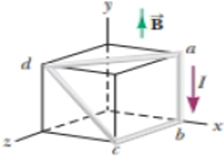
In Figure P28.28, the cube is 40.0 cm on each edge. Four straight segments of wire—ab, bc, cd, and da—form a closed loop that carries a current I = 5.00 A in the direction shown. A uniform magnetic field of magnitude B = 0.020 0 T is in the positive y direction. Determine the magnetic force vector on (a) ab, (b) bc, (c) cd, and (d) da. (c) Explain how you could find the force exerted on the fourth of these segments from the forces on the other three, without further calculation involving the magnetic field.
Figure P28.28

(a)
Answer to Problem 28P
Explanation of Solution
Given info: The length of each edge of the cube is
The formula for the magnetic force is,
Here,
As the current flows down and the magnetic from point
Substitute
The magnitude of the force is zero because an equal and opposite force cancels it due to which the magnetic force of
Conclusion:
Therefore, magnetic force vector on
(b)
Answer to Problem 28P
Explanation of Solution
Given info: The length of each edge of the cube is
The formula for the magnetic force is,
Here,
As the current flows down and the magnetic from point
Substitute
By using the Flemings right hand rule, the thumb points towards the x axis direction. Thus, the direction of the magnetic force is in
Conclusion:
Therefore, the magnetic force vector on
(c)
Answer to Problem 28P
Explanation of Solution
Given info: The length of each edge of the cube is
The formula for the magnetic force is,
Here,
Use Pythagoras theorem to find
Substitute
As the current flows at an angle and the magnetic from point b is perpendicular so the angle
Substitute
By using the Flemings right hand rule, the thumb points towards the z axis direction. Thus, the direction of the magnetic force is in z direction.
Conclusion:
Therefore, the magnetic force vector on
(d)
Answer to Problem 28P
Explanation of Solution
Given info: The length of each edge of the cube is
The formula for the magnetic force is,
Here,
Use Pythagoras theorem to find
Substitute
As the current flows vertically and the magnetic from point b is perpendicular so the angle
Substitute
By using the Flemings right hand rule, the thumb points towards the direction d
The direction of the force is,
Thus, the direction of the magnetic force is
Conclusion:
Therefore, the magnetic force vector on
(e)
Answer to Problem 28P
Explanation of Solution
Given info: The length of each edge of the cube is
By the parallelogram law of forces, when the forces on three of the arms of a parallelogram are provided then the magnitude of force on the forth arm is equal to the resultant of the other three forces.
According to the parallelogram law of vectors,
Here,
Conclusion:
Therefore, the force exerted on the forth segment from the forces on the other three can be calculated by the parallelogram law of vectors.
Want to see more full solutions like this?
Chapter 28 Solutions
PHYSICS:F/SCI.+ENGRS-W/WEBASSIGN
 Physics for Scientists and Engineers: Foundations...PhysicsISBN:9781133939146Author:Katz, Debora M.Publisher:Cengage Learning
Physics for Scientists and Engineers: Foundations...PhysicsISBN:9781133939146Author:Katz, Debora M.Publisher:Cengage Learning Principles of Physics: A Calculus-Based TextPhysicsISBN:9781133104261Author:Raymond A. Serway, John W. JewettPublisher:Cengage Learning
Principles of Physics: A Calculus-Based TextPhysicsISBN:9781133104261Author:Raymond A. Serway, John W. JewettPublisher:Cengage Learning College PhysicsPhysicsISBN:9781305952300Author:Raymond A. Serway, Chris VuillePublisher:Cengage Learning
College PhysicsPhysicsISBN:9781305952300Author:Raymond A. Serway, Chris VuillePublisher:Cengage Learning College PhysicsPhysicsISBN:9781285737027Author:Raymond A. Serway, Chris VuillePublisher:Cengage Learning
College PhysicsPhysicsISBN:9781285737027Author:Raymond A. Serway, Chris VuillePublisher:Cengage Learning
 Physics for Scientists and EngineersPhysicsISBN:9781337553278Author:Raymond A. Serway, John W. JewettPublisher:Cengage Learning
Physics for Scientists and EngineersPhysicsISBN:9781337553278Author:Raymond A. Serway, John W. JewettPublisher:Cengage Learning





